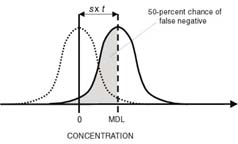
Figure 8. False negative probability when a sample contains the analyte at the method detection limit (MDL) concentration.
The USEPA MDL procedure does not address the issue of setting reporting levels. Both the USEPA MDL and the LT–MDL focus exclusively on minimizing the risk of reporting a false positive. At the MDL concentration, however, the risk of a false negative is not adequately limited. A sample with a true concentration equal to the USEPA MDL or LT–MDL has a 50-percent chance of not being detected (Keith, 1992). This is shown in figure 8, where the frequency distribution is centered on the calculated MDL. Assuming that the MDL concentration does, indeed, represent a detection “limit” (that is, the analyte cannot be detected reliably at less than this concentration), then up to 50 percent of the measurements made of a sample having a true concentration equal to the MDL would be less than the MDL (shaded region in fig. 8) and, thus, would result in a false negative. The NWQL views a 50-percent probability of a false negative as unacceptably high for use of the MDL as a reliable reporting level.
 |
|
Figure 8. False negative probability when a sample contains the analyte at the method detection limit (MDL) concentration. |
In establishing the reporting level, the NWQL has set the acceptable rate of false negatives at no more than 1 percent. This requires the use of a different value from the LT–MDL as the reporting level. The laboratory reporting level (LRL) has been devised to meet this requirement and is comparable to the reliable detection level of Keith (1992) when the false positive and false negative rates are set at <1 percent. The LRL is calculated from the LT–MDL, as follows:
LRL = 2 x LT–MDL.
As shown in figure 9, multiple measurements of a sample having a true concentration at the LRL should result in the concentration being detected and reported 99 percent of the time. Note that the reported concentration can be lower or higher than the true concentration at LRL. One percent of the measurements of this sample would result in a non-detection (shaded region in figure 9), because the measurements fall below the LT–MDL (again assuming that the LT–MDL represents a true “detection limit”).
An additional feature of the new reporting conventions is that, unlike the MRL convention that was used historically by the NWQL, positive detections below the LRL are not censored. Detected analytes with concentrations between the LT–MDL and the LRL are reported as estimated. This is because a detection in this region should have a <1-percent probability of being a false positive. Even less censoring occurs in information-rich methods where estimated concentrations are provided for analytes detected below the LT–MDL.